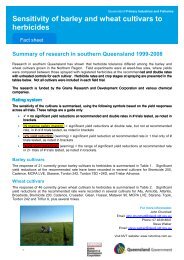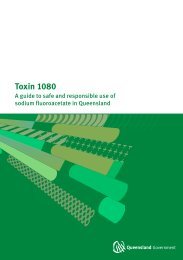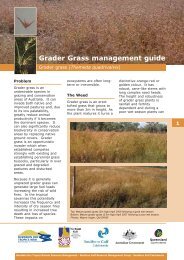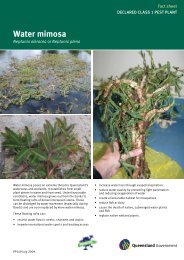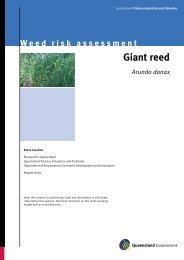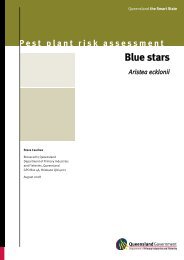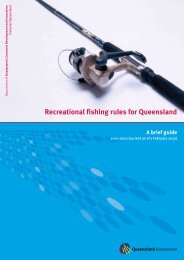Insect Control in Stored Grain - Department of Primary Industries
Insect Control in Stored Grain - Department of Primary Industries
Insect Control in Stored Grain - Department of Primary Industries
Create successful ePaper yourself
Turn your PDF publications into a flip-book with our unique Google optimized e-Paper software.
Table 7: Malt<strong>in</strong>g barley on-farm - <strong>Insect</strong>icide application rates for protection <strong>of</strong> malt<strong>in</strong>g<br />
barley. Use <strong>in</strong>secticides only if approved by your buyer or handler. Maltsters prefer barley without residual<br />
treatments, and some <strong>in</strong>sects are resistant to all listed protectants, so consider non-chemical alternatives.<br />
<strong>Insect</strong>icide 1<br />
(for Trade names – see table 9)<br />
Storage period<br />
6 weeks- 3 months-<br />
3 months<br />
9 months<br />
Rate/ Cost<br />
tonne<br />
2<br />
3 Rate/<br />
tonne<br />
2<br />
Cost 3<br />
Withhold<strong>in</strong>g period 4<br />
Apply a mixture <strong>of</strong><br />
either fenitrothion 6 mL 18-20 c 12 mL 35-40 c 90 days for high rate<br />
or<br />
4 mL 15-20c 4 mL 15-20c No WHP. May not be generally<br />
deltamethr<strong>in</strong><br />
available. Note – check with<br />
(250g/l) + pip.<br />
butoxide<br />
With either<br />
maltster before us<strong>in</strong>g.<br />
methoprene<br />
(200 g/L product)<br />
5 mL 150-160c 5 mL 150-160c No WHP<br />
or methoprene<br />
(50 g/L product)<br />
20 mL 100-140c 20 mL 100-140c No WHP<br />
or S-methoprene<br />
(30 g/L product)<br />
Notes on Table 7:<br />
20 mL 230-240c 20 mL 230-240c No WHP<br />
Trade names <strong>of</strong> these <strong>in</strong>secticides are listed <strong>in</strong> Table 9.<br />
1. Always check dose rates and all other details on product label. The table above is a guide only.<br />
Products such as Relden pluS IGR ® is a s<strong>in</strong>gle t<strong>in</strong> formulation mixture conta<strong>in</strong><strong>in</strong>g both chlorphriphosmethyl<br />
(500g/L) and S-methoprene (30g/L)<br />
2. Dilute liquid concentrates <strong>in</strong> water at the specified rate per litre, then spray 1 litre <strong>of</strong> the mixture per<br />
tonne <strong>of</strong> gra<strong>in</strong> while augur<strong>in</strong>g the gra<strong>in</strong>.<br />
3. Costs (cents per tonne <strong>in</strong> 2007) for chemicals only are presented as an approximate guide. Large<br />
pack sizes are cheaper per tonne treated than small packs.<br />
4. <strong>Insect</strong>icide residues must not exceed Maximum Residue Limits (MRL). Where application rates<br />
exceed MRL you must wait the withhold<strong>in</strong>g period to allow residues <strong>in</strong> the gra<strong>in</strong> to decay to less than<br />
the MRL before sell<strong>in</strong>g the gra<strong>in</strong>.<br />
Apply<strong>in</strong>g protectant <strong>in</strong>secticides<br />
Protectant chemicals will work <strong>in</strong> all types <strong>of</strong> storages with no modifications required, but they must be<br />
applied evenly to gra<strong>in</strong> to be fully effective. Simple, correctly calibrated application equipment is needed.<br />
• Apply the correct dose – under-dos<strong>in</strong>g will result <strong>in</strong> reduced protection; over-dos<strong>in</strong>g is wasteful and<br />
may cause gra<strong>in</strong> to be rejected by buyers or held for longer until residues decl<strong>in</strong>e to levels accepted<br />
by markets.<br />
• Mix the concentrated <strong>in</strong>secticide <strong>in</strong> clean conta<strong>in</strong>ers with ra<strong>in</strong>water if possible - alkal<strong>in</strong>e water causes<br />
<strong>in</strong>secticides to break down very quickly; don’t mix concentrates directly, dilute first, then mix; don’t<br />
hold mixed pesticides for more than a few days - mix just enough spray and use it as soon as<br />
possible.<br />
• Apply protectants to gra<strong>in</strong> while it is be<strong>in</strong>g augured. Spray <strong>in</strong>to the auger hopper or <strong>in</strong>to the auger<br />
cas<strong>in</strong>g. Use a flow meter.<br />
• High-volume pumps allow bypass to agitate liquid spray mixtures; other pump types may be used<br />
with care; thoroughly wash equipment with water after use.<br />
10





